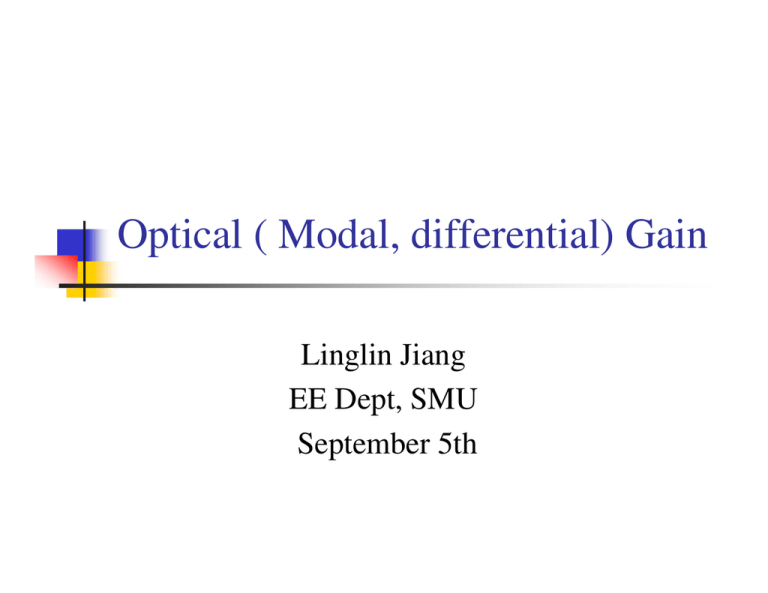Optical ( Modal, differential) Gain
advertisement

Optical ( Modal, differential) Gain Linglin Jiang EE Dept, SMU September 5th Contents Definition of Gain ( optical, differential, modal gain.) Transitions between the conduction and valence subbands of a quantum well. Fermi’s Golden Rule. Optical Gain. Modal Gain. Differential Gain. Definition of Gain Optical Gain: In terms of the difference between the stimulated emission and absorption rates. Modal Gain: which is the material gain adjusted to take into account the poor overlap that always exists between the optical mode and the electron envelope function in the quantum well. (I.e: modal gain=material gain* confinement factor) Differential gain: The rate at which gain increases as we inject more carriers, dg/dN. Transitions between the conduction and valence subbands of a quantum well. Cont’ All transition are drawn with equal transition energy and equal in-plan k vector. The allowed transitions have strong transition probabilities. The forbidden transitions have zero transition probability in an infinite barrier quantum well and weak probability at best in a finite barrier quantum well. Fermi’s Golden Rule---the transition rate We→h We→h = 2π H ' 2 eh H (r ) is the timedependent perturbation to the original Hamiltonian, it is to induce electronic transitions between the conduction and valence bands. Ee ,h are the initial and final energy of the electron. ' δ ( Ee − E h − ω ) 1 Where: H eh' ≡ ψ h H '(r )ψ e = ψ h* H '(r )ψ e d 3 r v 2 ^ e H (r ) = A(r ) e⋅ P 2m0 ' 3 Some description about the Fermi’s Golden Rule Optical gain in semiconductor is caused by photon-induced transitions of electrons from the conduction band to the valence band. Fermi’s Golden Rule characterizes electronphoton interactions in the crystal. It gives the transition rate for a single pair of conduction and valence band states. Fermi’s Golden Rule assumes the electron initially occupies a single state which makes a transition to one of a large number of final states. Cont’ Fermi’s Golden Rule is applicable to many systems where interaction with photons is of concerns. The delta function indicates that the difference between the initial and final energy (Ee − Eh) of the electron must be equal to the energy ω of the photon that induced the transition. The use of the delta function here implicitly assumes that We→ h refers to a single transition rate within a continuum of states The total transition rates ∝ 1 1 dN s Wc →v = We→h dN s = We→h dk v v dk 2π ' 2 = H eh δ ( Ee − Eh − ω ) ρ (k )dk (4) Cont’ The downward and upward transition rates are: Wc →v = Wv →c = 2π 2π H ' 2 eh ρ red f c (1 − f v ) (4) H ' 2 eh ρ red f v (1 − f c ) (5) where : H ' 2 eh eA0 2 =( ) MT 2m0 2 (6) f c and f v : the Fermi distribution. M T : the transition matrix element. ρ red : the reduced density of states. A0 : the vector potential can be taken as a constant. Some notes about optical Gain Each downward transition generates a new photon, while upward absorbs one. If the number of downward transition per seconds exceeds the number of upward transition, there will be a net generation of photons, and optical gain can be achieved. Optical gain in the material is attained when we inject a carrier density beyond N tr such that the quasi-Fermi levels are separated by an energy greater than the band gap. The simple formula for optical gain. The optical gain: 1 dΦ g≡ Φ dz (7) Where Φ is the photon flux ( the number of photons per cross section area unit in the unit of time) and z is the direction of the electromagnetic field propagation, And: dΦ (8) = W −W dz c →v v →c Expanding the gain formula The Photon flux: c 1 2 2 2 Φ (ω ) = ( )( n ε 0ω A0 ) ω ng 2 1 ng = neff + ω (d neff / dω ) Where: :The index of refraction in the crystal. n :The group index of refraction. ng :The effective index of the guided mode neff (9) (10) Cont Replace (4),(5),(6),(8),(9) into (7): g( ω) = ( 1 πe ng 2 ) ω ε 0 cm0 2 n 2 MT 2 ρ red ( Eeh − E )( f c − f v ) ' g Total Gain The total gain is found by summing over all subband transition pairs.: g( ω) = g sub ( ω , nc , nv ) nc nv Where: nc , nv are the quantum numbers in the conduction and valence subbands. Note: Each subband transition will have its own set of envelope function and subband gap. The optical gain experienced by an incoming photon is very much dependent on the photon’s energy. When f c ( Ee ) > f v ( Eh ), g ( ω ) is positive, and an incoming light wave with photon energy ω will be amplified by the material. The requirement for gain at a photon energy is: E g < ω < E fc − E fv E fc , fv are the nonequilibrium quasi-Fermi levels in the conduction and valence bands.. Cont’ The quasi-Fermi level separation must be greater than the bandgap to achieve optical gain in the material. Under equilibrium conditions, E fc = E fv , and optical gain is impossible to achieve. Modal gain Mode gain is expressed in terms of the gain coefficient and the gain confinement factor. Multiple quantum wells have higher optical gain. Differential gain dg/dN. The differential gain is reduced as the optical intensity is increased. G ' Effects of differential gain ωr ∝ G ' high differential gain should lead to high modulation bandwidth. The Antiguiding factor or linewidth enhancement factorα ∝ G '−1 high differential gain should lead to low frequency chirp (α parameter) and narrow linewidth capabilities References Peter S. Zory, “ Quantum Well Lasers ”,Academic Press Inc, 1993. L. A. Coldren & S. W. Corzine, “ Diode Lasers and Photonic Integrated Circuits ”, John Wiley & Sons, Inc, 1995. Sandra R.Selmic, “ Multiple Quantum Well Semiconductor Lasers Emitting at Wavelength of 1310 nm and 1550 nm ”, Copyright by Sandra R. Selmic, 2002. Tso-Min Chou, “ Theory and Design Application of Strained separate-Confinement Heterostructure Quantum Well Lasers”, Copyright by Tso-Min Chou, 1995.






